Top News
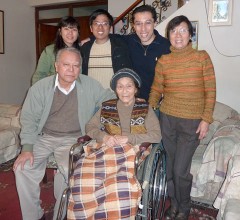
September 7, 2011 Hisao Miyagi, reporter of Ryukyu Shimpo, in Lima City
As the Peru Okinawa Kenjin-Kai marked the 100th anniversary of its foundation, first-generation Okinawan Peruvian Tsuyu Toyama, who currently resides in Lima City, Peru, turned 100 this year but remains in good health.
It has been 81 years since Toyama went to Peru when she was 19 years old. Experiencing an era of significant change, with tough times such as the war years, her life overlaps with the 100-year history of the Okinawa Kenjin-Kai. Toyama spoke from the heart, saying “I was able to overcome many hardships thanks to the strong relationship I share with so many Okinawan Peruvians. I will celebrate the 100th anniversary of the founding of the Association, and hope that it continues to strive to keep its activities going.”
Toyama was born in Awase, Okinawa City in 1911. Her father and her late husband, Zensei Toyama, who passed away in 1995 at the age of 83, emigrated to Peru a short time ahead of her arrival in 1930.
Toyama earned a living running a general store.
She says that she was discriminated against by other Japanese immigrants because, like other Okinawan people who emigrated to Peru before World War II, she mostly spoke the Okinawan dialect.
Toyama said, “Other Japanese immigrants looked down upon those of us from Okinawa, calling us ‘Okinawa-san.’ Although I experienced hardships, I somehow got through them, still determined to do my best in my life in Peru.”
Toyama and her fellow Okinawan immigrants supported each other through these hardships.
When the Pacific War began, Peruvian society changed drastically with Japanese schools and the Consular Office being closed as a result.
Seen as an enemy alien, Toyama was forced to live a low-profile life.
Toyama went on to face other hardships. She sent her eldest son and second son, who were both born in Peru, back to Okinawa to receive a Japanese education before the war began.
Toyama was the brink of despair when she heard that the unmarked Japanese passenger-cargo ship Tsushima-Maru, on which her second son was supposed to be, had been sunk by the submarine USS Bowfin, but fortunately, she later heard that her son had actually gone on a different ship. Toyama said, “I really regretted no leaving them in Peru. It was a terribly tough time for us.”
After the war, Toyama ran a restaurant and a hotel, and her husband served as the 36th chairman of the Japanese Association of Peru.
At 100 years old now, Toyama is still interested in Japanese and Okinawan social and political issues, saying, “I enjoy watching NHK (Nippon Hoso Kyokai, Japan Broadcasting Corporation) discussion programs.”
Toyama suffered a leg injury several months ago so she could not attend the gathering of elderly people, but all in all she is in good health. She said, “Okinawan people are tough and can be relied upon. I am proud of being Uchinanchu.” Tomaya continued, “I would like the Worldwide Uchinanchu Festival to go on into the future and hope that the spirit of Okinawa will be inherited by young people.”
(English Translation by T&CT, Mark Ealey)
Go To Japanese
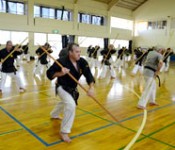
September 6, 2011 Kenichi Yoshida of Ryukyu Shimpo
The World Oshukai Dento Okinawa Shorin-Ryu Karate Do Kobudo Federation, which is based in France and functions as a non-profit organization for traditional Okinawa Shorin-Ryu karate and Okinawan kobudo, held a seminar in Yomitan Village from August 22 to 27.
More than 100 exponents of karate from its 30 chapters all over the world gained new inspiration as they learned about the spirit and traditional techniques of karate in Okinawa, the birthplace of it. The seminar was held for the seventh time this year.
The World Oshukai Cup, a biennial event, was scheduled to be held this year in Yomitan Village, but the event was scaled down to the seminar because the number of applicants dramatically decreased due to the nuclear accident after the Great East Japan Earthquake. The World Cup has been rescheduled for two years from now.
Head of the Federation Kenyu Chinen talked about the importance of the seminar, saying, “It is very significant for all students to learn about traditional karate in Okinawa, the birth place of karate, and what they learn here could eventually be of benefit to Okinawa.”
After graduating from Okinawa Fisheries High School, Chinen went to France by himself in 1976.
Thirty-six year-old Canadian Jonathan Blais, who came to Okinawa for the first time, said, “I would like to practice karate in Okinawa and get my 2nd dan.”
Twenty-eight year-old Polish karate exponent Anna Koros, who started karate when she was a college student, said, “I am doing my best to acquire my 1st dan. Karate is now part of my life.”
Fifty-five year-old Frenchman Pascal Sorel commented, “I thought there would be no worries in Okinawa about the nuclear situation following the Great East Japan Earthquake. I would like to practice my technique and become mentally stronger.”
(English Translation by T&CT, Mark Ealey)
Go To Japanese
September 4, 2011 Kenyu Uchima of Ryukyu Shimpo
At his meeting with Governor Hirokazu Nakaima, at the Okinawa Prefectural Office on September 1, Kimito Nakae, Japan’s administrative vice-minister of defense stated that the Government will submit an environmental impact report by this December on the effect on the environment of the relocation plan of the United States Marine Corps Air Station (USMCAS) Futenma to Henoko, Nago City. The Government will recommence moves on the relocation that effectively came to a halt after the regime change to the Democrat Party in 2009. It is clear that the Government intends to push through with the relocation despite the opposition of the Okinawan people. This will lead to objections from the Okinawa Prefectural Government, Nago City and other local people.
At a meeting of experts on security issues, entitled, “The Okinawa Question” scheduled to be held on September 19 in Washington DC, Governor Nakaima will ask for USMCAS Futenma to be relocated outside Okinawa. The Prefecture will further strengthen its position with regard to moving the Futenma replacement facility outside the prefecture and the gap between the positions of Prefecture and the central government on the Futenma issue will widen further.
The assessment of the plan to relocate the facilities at Futenma to Henoko, which was decided by the Liberal Democratic Party administration, and to build a V-shaped runway in the area of the Henoko coast with part of Oura Bay being reclaimed, is now at the stage of preparing a draft environmental impact report. It is at the final stages, now just needing its submission and evaluation. With the Democratic administration having made a public pledge for it to be “at the minimum, outside the prefecture,” the way to move forward on the relocation is still undecided.
In a joint statement with Japan and the U.S., on May 28, 2010, both governments confirmed their intention that the replacement for the Futenma Air Station be constructed at “Henokozaki and water area adjacent to Camp Schwab.” On June 21 at US-Japan Security Consultative Committee (2+2) they decided to build a V-shaped runway on that location.
At a meeting with Governor Nakaima on September 1, the Ministry of Defense’s position was represented by the administrative vice-minister of defense as well as Ayako Kimura, the counselor responsible for the Futenma relocation issue, Rou Manabe, the deputy executive director of the Regional Cooperation Division, and Satoshi Tanaka, the Okinawa Defense Director. During the closed meeting, there was a comment that a representative of the Ministry of Defense will release the government’s environmental impact report before December. On this occasion, only the beginning of the talks were open to the media. After the meeting with the Governor of Okinawa, on the topic of the Japan-US agreement in which it was decided to build a V-shaped runway at Henoko as the replacement of the facilities of Futenma, Nakae told reporters about the need to eliminate the risk surrounding the Futenma Air Station at the earliest stage possible, and with regard to the relocation process said, “We would like to make steady progress towards actioning the agreement at an early stage.”
(English Translation by T&CT, Mark Ealey)
Go To Japanese
September 3, 2011 Ryukyu Shimpo
Kumejima Town and Kona City of Hawaii, both of which have deep-sea water pipelines in their regions, indicated their intention to sign a sister-city agreement in Kona City on September 11 aimed at stimulating collaborative research on deep-ocean water and people-to-people exchange.
The Natural Energy Laboratory of Hawaii Authority (NELHA), which is located in Kona City, has deep-sea water pipelines boasting one of the world’s largest seawater intake capacities.
Mayor of Kumejima Town Choko Taira and 20 other people involved in the town will attend the ceremony.
Once the sister-city relationship is established, Kumejima intends to set up an office and the Kumejima chapter of the Hawaii United Okinawa Association to encourage collaborative projects in the fields of industry, education and culture.
Representatives from both the United States and Japanese governments and people from Okinawa Prefecture participated in the first New Energy Workshop held in Hawaii in August 2010. During that workshop, interested in what heard from their Kumejima counterparts, Kona City representatives suggested establishing the relationship with Kumejima Town. People from Kona City visited Kumejima Town on November 11 and formally sent a letter to Mayor Taira.
Kona City is located on the island of Hawaii and has a population of about 10000 people. Its main industries are tourism and agriculture.
The original facilities of NELHA were constructed at Keahole Point in 1980.
The NELHA seawater supply system has a daily pumping capacity of 14000 metric tons of water at an intake depth of 619 meters, 73000 metric tons at a depth of 675 meters and 160000 metric tons at 915 meters.
NELHA is involved in a diverse range of projects, including alternative energy production from renewable resources such as ocean thermal energy conversion, agricultural use and freshwater production and cultivation.
With the establishment of the Okinawa Prefecture Deep Sea Water Research Center (maja) in 2000, Kumejima Town is striving to boost the development of the area, focusing on deep sea water projects.
This March, the town compiled a report on fundamental research into the complex utilization of deep water, putting forward concepts for ocean thermal energy conversion.
With regard to visiting the United States, Mayor Taira said, “Kumejima Town and Kona City will be able to share information through the sister-city relationship, promoting deep-sea water projects.”
(English Translation by T&CT, Mark Ealey)
Go To Japanese
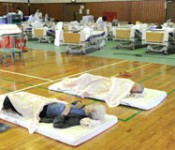
September 5, 2011 Ryukyu Shimpo
Disposal of a U.S. bomb found on the site of the Ureshinogaoka-Samaritan Hospital in the Arakawa District, Haebaru Town, was carried out on the morning of September 4. While this was being done, 200 critically-ill patients and 85 members of the hospital staff stayed on-site because they were unable to evacuate to a safe area. It is extremely rare for this kind of bomb disposal work to be carried out with so many patients and staff members remaining in the hospital and its related facilities within the designated evacuation area (222 meters radius). However, according to the headquarters for the disposal operation headed by Toshiyasu Shiroma, the Mayor of the Haebaru Town, and a spokesperson of the hospital, there have not been any reports of injury or ill-health from the patients and other people.
This operation highlighted the fact that in cases of unexploded ordnance disposal operations, the facilities affected must pay the cost of the evacuation of their patients and staff members because administrative guidelines for people unable to evacuate have not been established by the central government, the local government and the municipalities. The evacuation for the people from the hospital and local residents started at 9:00am and finished at 10:30am. While the evacuation was being carried out, a Ground Self-Defense Forces bomb disposal team removed the fuse from unexploded ordnance in the barrier metal liner plates on the hospital site. This spot was just 20 meters from the outer wall of the building still occupied by many patients and staff members.
Three hundred fifteen people, including patients and others who live in the facilities of Ureshinonosono, Ureshinonosato and Mutsumiryo moved to the nearby Chimugukuru-Kan (Heath Welfare and Disaster Management Center managed by Haebaru Town), to be safe during the disposal operation. About 100 of the 110 residents within the evacuation area went to the facility at Kankyonomori Fureai. The unexploded bomb in question was found on July 25 on the hospital site during reconstruction work.
According to research carried out by the Ryukyu Shimpo, in the ten years since 2002, a total of 16 cases in which hospitals or the welfare facilities have been included within the evacuation areas for unexploded ordnance disposal work. In three of these cases the disposal operations were carried out with people still in the affected facilities.
Toshiyasu Shiroma, Mayor of Haebaru Town, said, “We are very relieved that the bomb disposal work has gone well. But even so, the issue of unexploded ordnance on Okinawa is part of the negative legacy that the Government caused during World War II. By rights, the Government should assume final responsibility for this.”
(English Translation by T&CT, Mark Ealey)
Go To Japanese
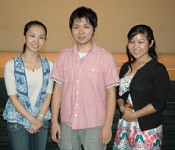
September 2, 2011 Ryukyu Shimpo
At the 46th Ryukyu Classical Art Contest (sponsored by the Ryukyu Shimpo), held in August, three performers of Okinawan origin from Brazil and the United States were awarded passes in the top award section of the ryubu or Ryukyu Classical Dance. They are Satoru Saito, a 24 year-old resident of Sao Paulo, Eliza Miyuki Miyagi, a 26 year-old resident of Naha City, and Akiko Yamauchi, a 26 year-old resident of Los Angeles. They won their awards on the back of their efforts to continue to learn the arts of their roots.
A third-generation Okinawan born in Sao Paulo, Saito’s grandparents were from what was formerly Ozato Village. He began to learn ryubu at the age of five. At the age of seven, he visited Okinawa for the first time to join the Tamagusuku Ryu Senju Kai. He spent one year studying at the Okinawa Prefectural University of Arts and now is a fourth-year student of University Uninove in Sao Paulo. He has leave of absence from his university for three months from June to prepare for the contest in Okinawa. He said, “I am overwhelmed by feelings of gratitude towards my teachers. I love the performing arts of Okinawa and I would like to convey them to the people of Brazil.”
Miyagi, who was born in Sao Paulo and has a second-generation Okinawan father, started to learn ryubu at the age of 13. She studied at the Okinawa Prefectural University of Arts when she was 20 and after finishing her studies there continued to practice in the Tamagusuku Ryu Gyokusen Kai, supporting herself by working at a post office. When she passed at the top level of the awards, Miyagi smiled as she said, “I really wanted to give a more powerful performance. I would like to perform classical and new dances. Ryubu allows me to connect with Okinawa.”
Yamauchi’s father was born in what used to be Koza City and her mother in Nago City. She was born in Los Angeles and began to learn ryubu at the age of seven. She belongs to the Tamagusuku Ryu Kansen Kai. Yamauchi said, “I feel my roots through ryubu. I am proud of being Uchinanchu and want to continue studying ryubu.” After receiving the top award, she said, “I still have many things to learn, and want to improve the quality of my performance. I would like to convey all that is good about ryubu.”
(English Translation by T&CT, Mark Ealey)
Go To Japanese
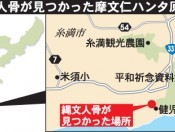
August 31, 2011 Ryukyu Shimpo
At the Mabuni Hantabaru archeological site in Itoman City researchers have found a forearm bone of a male roughly 169 centimeters tall among the bones of 85 people from the late Jomon period, dating back 3,000-4,000 years.
The bone, measuring about 28 centimeters in length, is believed to be from a man who must have been extremely tall for the late Jomon period, since the average height of males of that period was only about 158 centimeters.

Takayuki Matsushita, honorary head of the Doigahama Site Anthropological Museum in Yamaguchi Prefecture, explains the place where the bone of a Jomon man was found in the Mabuni Hantabaru archeological site in Itoman City in July 2009.
Takayuki Matsushita, honorary head of the Doigahama Site Anthropological Museum in Yamaguchi Prefecture, revealed the discovery.
Even on a national scale, it is very rare to discover a bone of such a tall Jomon man. It is the first time that the 169-centimeter estimated height of the person is found in Kyushu, Ymaguchi and Okinawa.
Matsushita said, “Although it is still unclear as to whether the bone belongs to a man who evolved from the Minatogawa Man, a prehistoric inhabitant of Okinawa, or a Jomon man, who came down from the Kyushu area to Okinawa, it is definitely a valuable discovery in terms of research on people from the Jomon period.”
According to Matsushita, the thickness of the bone and its development indicates that it was from a sturdy person of muscular build. The ulna was discovered in perfect shape along with the radius.
The museum conducted the excavation of the five square meter site in Itoman in collaboration with the Itoman Municipal Board of Education from July 2007 to July 2010.
The ulna of another male estimated to have been 164 centimeters tall have also been unearthed at the site. The bones reveal that these two men were the tallest of the people whose remains were discovered in the site.
Among the 85 sets of bones unearthed in the site, there were 32 male adults along with 31 female adults, six infants and nine children, as well as seven sets that could not be categorized for age at the time of death.
The site is a burial ground, where all the bones were collected in once place.
The researchers unearthed 230 incunabula, of which 80 percent were shell products, including rare items such as perforated modified tridacna plate-like products.
The Doigahama Site Anthropological Museum intends to announce the results of its survey at the 17th Doigahama Symposium in Shimonoseki, Yamaguchi Prefecture, on September 3.
(English Translation by T&CT, Mark Ealey)
Go To Japanese

August 31, 2011 Ryukyu Shimpo
According to population estimates published by the Statistics Division of the Okinawa Prefectural Government on August 31, as of August 1, Okinawa’s population had reached 1400171 people. This figure is based on a survey of the increases and decreases in the Basic Resident Register. A total of 871 people have been added since the previous month, with 8429 since the same month of the previous year. There are 543992 households in total. The increase is 883 households over the previous month and 10090 more households over the same time of the previous year. While the population of the entire country has demonstrated a downward trend since 2009, the population of Okinawa has consistently increased since the end of war. The prefecture’s population has now topped 1.4 million, 13 years since it reached 1.3 million in November, 1998.
With regard to the population of individual municipalities, the highest growth rate since last year is in Yonabaru Town up to 4.6%, followed by Tokashiki Village which is up to 2.6 %, and Nakagusuku Village, up to 2.3%. Meanwhile, the highest rate of decline since last year is Izena Village, which is down 3.8 %, followed by Iheya Village, down 3.6 % and Tarama Village, down 3.3%.
(English Translation by T&CT, Mark Ealey)
Go To Japanese
August 30, 2011 Ryukyu Shimpo
Lease contracts between the Government and local landowners providing their land for military use will expire on May 14, 2012. One hundred and seventy four landowners with land on 17 facilities who agreed to enter into a contract with the government the previous time round, in 1992, have refused to sign this time. The combined total land area of their property amounts to 426998 square meters (308 hitsu numbers).
The refusal by landowners to enter into a contract will be a first for six facilities of the Okuma Rest Center, Camp Schwab, Kin Blue Beach Training Area, Camp Courtney, Camp McTureous and White Beach. There were no rejections of contract offers the previous time in 1992.
On August 29, the Okinawa Defense Bureau announced that the Defense Minister approved the procedures for the use of this land for 17 facilities based on the Special Land Lease. A total of 3832 landowners have not responded to requests to lease their lands for military use and the Defense Minister has moved to carry out the procedure in these cases. With 174 new landowners rejecting the contracts, the number of landowners who do not confirm their approval will reach about 4000 with their land area totaling 72 hectares.
With regard to the reasons why the landowners have not yet responded to approaches on contracts, a spokesperson for the Bureau stated, “There are several reasons for this, such as that some people just want to have it returned, or they want to use the land by themselves, and some are motivated by political reasons.”
According to the Bureau, most of the lease contracts for private or publically owned land used by U.S. Forces in Okinawa will expire on May 14, 2012.
(English Translation by T&CT, Mark Ealey)
Go To Japanese
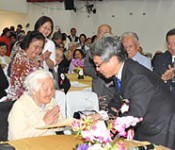
August 29, 2011 Hisao Miyagi of Ryukyu Shimpo, Sao Paulo, Brazil
The Brazil Okinawa Kenjin-Kai celebrated the 85th anniversary of its founding with about 700 people of Okinawan origin attending at the Kenjin-Kai Hall in Sao Paulo City, Brazil, on August 27 local time. The participants paid tribute to their forerunners’ achievements and vowed to convey their Uchinanchu spirit to the next generation.
The Brazilian side was represented by Shinji Yonamine, Chairman of the Okinawa Kenjin-Kai and Kazuaki Ohbe, Japanese Consul in Sao Paulo, and the Okinawan side by Yoshiyuki Uehara, Prefectural Vice Governor; Toshiyasu Shiroma, Chairman of the Okinawa Municipalities Association and Mayor of Haebaru Town with many others in attendance.
Yonamine said, “More than 10000 immigrants from Okinawa moved to Brazil after the war. They worked together with their forerunners who had moved here before the war to build the foundations of the Brazilian Okinawan community. We would like to convey our respect and gratitude to our predecessors for their achievements.”
Vice Governor Uehara presented a certificate of commendation to 107 year-old Matsu Uechi, who moved to Brazil from Nago City, in 1924. She was delighted to receive the recognition, saying, “That I have been able to live here for such a long time is thanks to my family members and everyone around us.”
Four other men and women over 100 years old and 43 people over 90 years old but under 100 years old were awarded certificates of commendation by the Okinawa Prefectural Government.
At the celebration party with its entertainment, attractions and performances, the members of the Okinawa Prefectural South America Caravan, the Brazil branch of Ryukyu Matsuri Daiko and the Eisa section of the Lequios Performing Arts Club performed the Eisa dance parade. To close the event, all the participants and the performers formed a kachashi dance circle through the venue.
Three hundred and twenty-five people landed in Brazil from Okinawa on board the Kasado-maru, in June 1908. From that time on, Kenjin-Kai organizations were established throughout Brazil, with their united body, the Kyuyo-Kai, the predecessor of the Brazil Okinawa Kenjin-Kai, being founded in 1926.
(English Translation by T&CT, Mark Ealey)
Go To Japanese
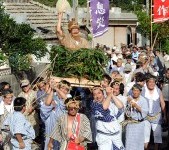
August 28, 2011 Ryukyu Shimpo
On August 27, as a part of the Shinugu, a traditional festival in Oku, Kunigami Village, Beenkuikui, a ceremony unique to the village was also held. In the ceremony, young people placed the eldest person in the village on an uhi (tub) and paraded through the village, praying for a good crop and perfect health for all in their region.
Many people from the region and its Kyoyukai (a social organization for people from the same community who now live in an urban center far from home) took part in the ceremony.
While the Shinugu in Oku occurred over three days from August 25, the Beenkuikui was held only on the final day.
Eighty-six year-old Eishu Sakihara, a farmer who grows citrus fruits such as kabuchii, was the one on the tub this year.
After the end of the ushindeku, in which the women perform the dances, there were displays of karate and bojutsu (staff-wielding). Young people marched toward an open space called ashagima, beating their drums and shouting “Beenkuikui” and “Eiyaa-saa” as they went. The participants followed on behind them, praying for prosperity in the region.
Sakihara said, “The ceremony was a success. I hope that Oku goes on from strength to strength, and I want to live even longer yet to be part of that.”
(English Translation by T&CT, Mark Ealey)
Go To Japanese

Go To Video










 Webcam(Kokusai Street)
Webcam(Kokusai Street)


